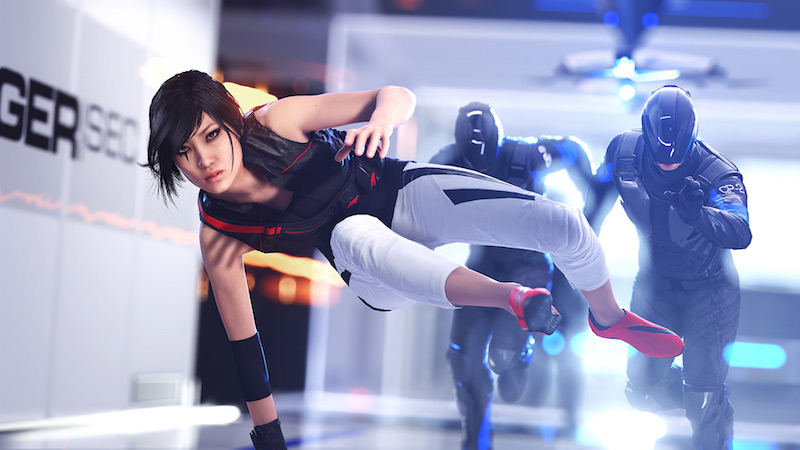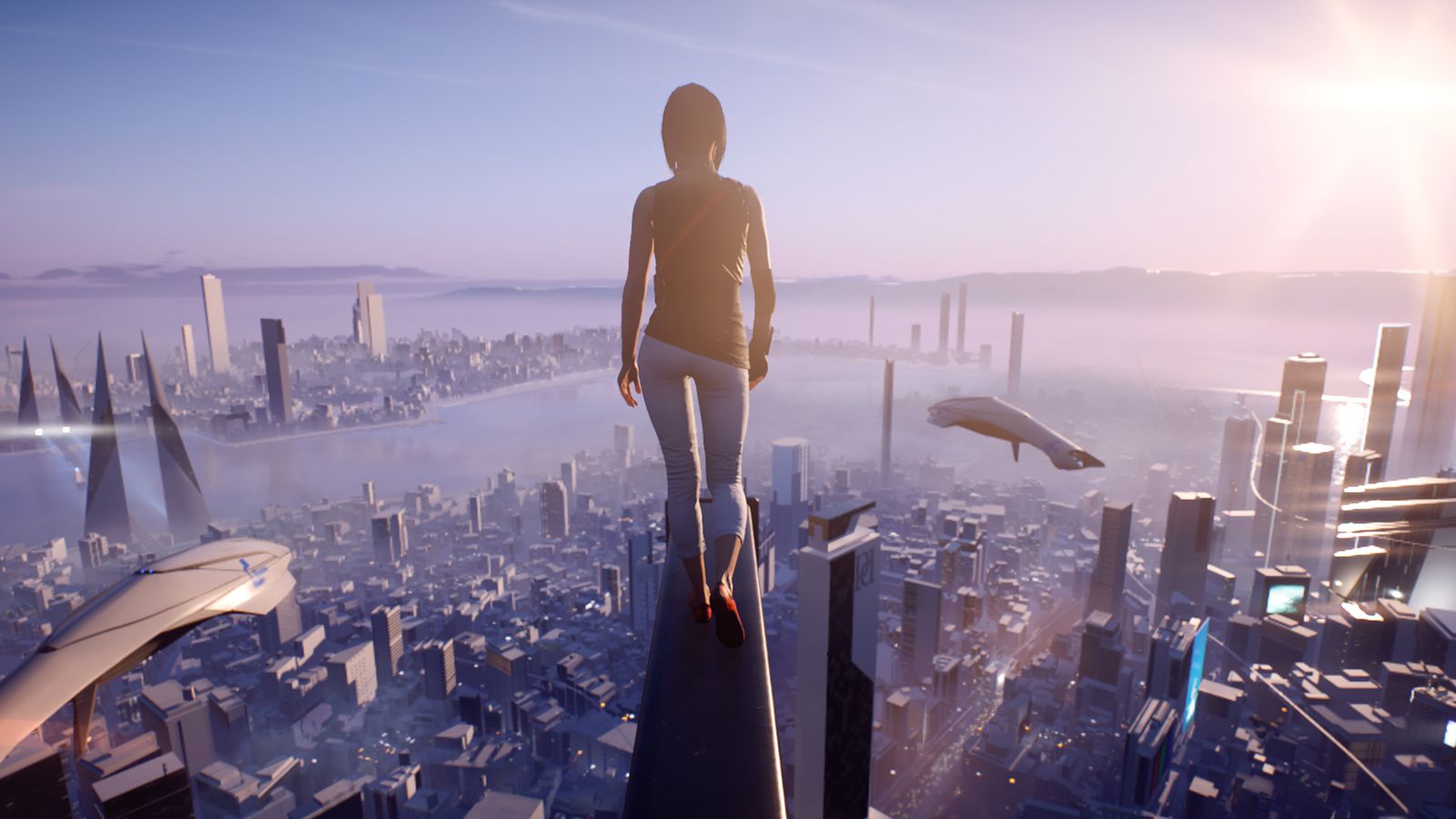Imagine combining all of the greatest action movies ever made into a single collection of mind-blowing, adrenaline-inducing, mind-numbing, breathtaking animated moments with a gripping narrative for an unexpected experience.
Games like these are rare, and when they do appear, you can be sure that the story they tell will be remembered for years to come.
Journey of Mirrors Edge

Up until a few years ago, Electronic Arts was not mainly designed to take chances on novel intellectual property. Dead Space, the massive publisher’s first attempt at creating a brand-new video game franchise, was a success over the holiday season, and now we have the company’s most recent try. The means for this is Mirror’s Edge.
Mirrors tells the story of Faith, a runner in an unnamed city where the repressive totalitarian regime has practically wiped out all uniqueness. Faith’s task is to communicate vital information to a subterranean network that still retains some degree of independence. She has remarkable acrobatic skills and outperforms “Blues” in terms of speed, leaps, and swings (cops). The players discover during the course of the game that Kate, Faith’s sister, has been falsely charged with murder.
Faith is on a mission to clear her name. When operating as Faith, players have a limited set of moves to choose from, but given the three-button control mechanism, this is nonetheless amazing. She can wall sprint, dangle on poles, parachute roll out of large jumps, and perform a variety of other parkour-inspired actions.
It’s perhaps not in the spirit of the sport, but it’s close enough and can be a lot of fun once you get into a good rhythm of ups and downs and racing on flat walls. On-screen details heighten the sensation of motion and soar into the air. Faith’s legs pump during a long jump, and her hands bang into doors as she breaks past, all of which is emphasized by camera movement and camera motion on the side of the screen. All of those elements come together to provide the best sense of motion and energy we’ve ever experienced in a videogame.
“Mirror’s Edge” aims to express authenticity and tangible interaction with the world, as well as a level of freedom of movement never seen in the first-person category previously. The game includes a technology called “Runner Vision” to assist the player in creating these chains of maneuvers. Its objective is to depict the world in the manner a Runner would see it, spotting exit points quickly.
As Faith reaches an object, the algorithm spotlights it by coloring it red. Pipes, ramps, and accessible doorways, for example, are useful for progression. However, this mechanism may not always recommend the optimal course of action. You’ll need to practice and develop your skills because even a minor blunder can send you crashing down onto the pavement below or at the very least, lead you to lose your stride.
You’re supposed to play every level numerous times to figure out which paths will get you the most points, which is excellent after the tenth time but maybe a frustrating series of failed attempts, mistimed jumps, and full stops the first few times. If you need a helping hand, press and hold a button to activate runner vision, which directs the camera toward your target. However, this is an imperfect approach that sometimes takes you more towards a short-term goal and other times towards your final goal.
While the images earn attention for their particularly sharp design, the soundtrack is equally deserving. Faith’s breathy heaves and slow steps are genuine sound effects that add to the sensation of speed and urgency. Although the voice acting is excellent, it is the throbbing, driving soundtrack that really stands out. Its constant flow complements Faith’s most flowing passages, while delicate notes fill in the silence during quiet moments.
The great musical adventure comes to a close with a fantastic voice piece that plays during the game’s closing credits. Mirror’s Edge is energizing, irritating, satisfying, and perplexing all at the same time. It isn’t for everyone, and it frequently falters for a game that places such a premium on speed. Despite its flaws and disappointments, it manages to make some spectacular leaps; it simply can’t land them.
Mirror’s Edge Catalyst (2016)

Mirror’s Edge: Catalyst is a free-running first-person adventure, similar to its predecessor. The key difference this time is that instead of a succession of linear stages, it’s set in a continuous open world playground. Rather than an open world in the vein of GTA, this is more akin to a Zelda-style huge base, with new places opening up as your toolkit grows. The magrope, a grappling hook that attaches to particular spots in the world, is introduced in Catalyst.
Purchasing and modifying this provides new methods to navigate around the city. While Catalyst’s gameplay is as rich, nuanced, and thrilling as its precursor, a fault in the game’s new fighting system prevents it from being the flawless Mirror’s Edge remake people hoped for. For those who like the free-running throughout the first Mirror’s Edge, it’s all here, more or less, as you recall it.
While unlocking Faith’s full moveset from the first game in the game’s latest technological tree takes around an hour, this will allow your memorization time to adapt to how fast Mirror’s Edge is. After all, it has been almost eight years. Running up walls, slipping under pipelines, and executing rescue rolls from enormous altitudes all demand precise time and acute senses, and it’s all here.
When you have to focus while sprinting around a world, you enjoy your environment more, and even merely getting from one spot to another seems satisfying. We believe that Mirror’s Edge’s relative complexity of platforming makes it one of those games that certain players will always misinterpret—yet for those who get it, nothing will be able to deliver the same exhilaration.
Overall, it’s breathtaking, coming as close to portraying a futuristic city experience in a game as I’ve ever seen, and it feels like a lot more detailed version of the world you’ve only seen in linear snippets before. Traveling between these neighborhoods is a joy, thanks to DICE’s use of visual effects and sound design to represent player mobility.
It’s a bit like running through the star gate in 2001: A Space Odyssey—a fascinating swirl of continually altering color with Faith flowing through it. Mirror’s Edge was panned in 2008 for its shoddy combat system, which depended on neutralizing adversaries and relatively basic melee assaults in addition to firing firearms. Guns are no longer legal, which is good news—but the rest is a bit more mixed.
At its most basic level, the combat is sharper to the original game. If Faith is sprinting at full speed, a quick push of the light attack key will shove an adversary out of the way, allowing her to continue running. It’s practical and there to help you with your free-running weaponry in that way, and it feels like something that would’ve made perfect sense in the original game.
The story route is jam-packed with segments that are noticeably better than those in the first game. Outside of the main open world center, Catalyst brings you to a variety of locations. One episode, in which you must destabilize a skyscraper’s earthquake pillars before making a perilous escape, is one of the best single-player levels players have played in years.
The adventures do an excellent job of combining gorgeous scenery with high-pressure set pieces. Now that we’re clear on the tale, everyone’s looking forward to just spending more time in that world—despite the fact that this is primarily a running game, you will find yourself frequently pausing to gaze at the incredible city skyline from various perspectives.
What Went Wrong with Mirror’s Edge?

Obviously, the vast and rapid rise of the games business and gaming as a medium has been a net good, but there are some limitations. One of them is a fear of taking risks; big publishers, in particular, are wary of producing unique and experimental games, believing that the revenue they create would not be sufficient to justify the massive sums that almost all games demand these days in creation.
As a result of this uniformity, really incredible experiences have become something of an endangered species, which is why the recollection of similar games from a not-too-distant age has grown all the more valuable over time. Mirror’s Edge was one of these games, and it came from DICE and EA, two companies that have come to symbolize the risk-averse approach to game creation that has come to define the AAA area in this day and age.
The original Mirror’s Edge is a cult favorite with a devoted fan base that believes by the game to this day, and despite the fact that its sequel fell short of the mark in more ways than one, there’s no lack of people who’d love nothing more than to see the series return, but how did we even get to this stage?
Frankly, what the game had to offer was unlike anything else we’d ever seen before. Platformers and first-person action games were plentiful in 2008, but first-person platformer like Mirror’s Edge was a one-of-a-kind experience. The game offered something fresh, with a total and utter concentration on parkour and movement, and best of all, it assured that those qualities were exactly as amazing in practice as they were in theory. Fans of the game demanded a sequel for a long time, but their pleas were ignored.
In 2010, we got a phone game, which was shockingly well-made and pleasant. However, as time passed, gamers began to lose hope that a genuine complete console successor would ever be released. Of course, fading expectations were finally compensated: Mirror’s Edge: Catalyst, which was published in 2016, was initially revealed in 2013, nearly a decade after the first game.
Fans were ecstatic, as they should have been, and the information released by DICE and EA about the relaunch in the years after the revelation was more than reassuring. The open world was obviously, the most appealing feature because the prospect of being turned free in a massive world around Mirror’s Edge’s outstanding parkour features was tantalizing.
Unfortunately, when the game was finally released, it fell short of expectations. The open environment, which was supposed to be one of its greatest assets, ended out as being its most significant flaw. It was too flat, felt too bleak, looked too formulaic, and the optional diversions it provided were simply not enjoyable.
In hindsight, it became evident that Mirror’s Edge’s centered, linear design was ideal for this formula— whizzing through firmly constructed stages in the original was more fun than the free-form route discovery of Catalyst, after all, because the former was a much more carefully selected journey that very tellingly concentrated about what the game was excellent at. Because of the variation of the latter need, the franchise’ artistic style and scenario layout that struck out in the brief and limited adventure that was the first game became uninteresting and monotonous when transferred to a substantially longer, open-world experience.
Future Of Mirror’s Edge Franchise Will We See Another Game?

Mirror’s Edge Catalyst was released almost six years ago, and fans are still speculating if there is another game in the series. A launch date for Mirror’s Edge 3 has yet to be confirmed. It’s possible that Mirror’s Edge 3 will be published on PS5, PS4, PC, and Xbox in the future. Mirror’s Edge doesn’t really appear to have been discontinued or terminated by EA. Despite the fact that sales of the first Mirror’s Edge on PS3, PC, and Xbox 360 were poor in 2009, Mirror’s Edge Catalyst was considered a success, with the game earning enough to break even. The series’s site is still up and running, as is the associated app.
The existence of a new Mirror’s Edge title has yet to be established. Although a sequel is possible, Mirror’s Edge 2 was already scrapped in 2011 when early prototypes were found to be underwhelming. Nevertheless, in 2016, Mirror’s Edge Catalyst was released as a precursor to Mirror’s Edge on PS4, PC, and Xbox One, focused on heroine Faith’s origins. Mirror’s Edge 3 might be a continuation, a reboot, or perhaps a whole new narrative.
